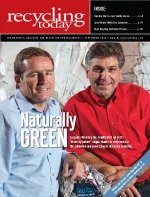 Index is based on December 1980 average prices as 100; Source: U.S. Bureau of Labor Statistics Index is based on December 1980 average prices as 100; Source: U.S. Bureau of Labor Statistics |
A material recovery facility (MRF) operator in the Midwest describes markets for secondary plastics as "all over the board," depending on the type of material, adding that things are "definitely kind of rough" for some resins.
He says post-industrial HDPE (high-density polyethylene) still fetches 30 cents per pound "if you know where to sell it." However, pricing for post-consumer HDPE ranges from 15 to 20 cents, again depending on the market.
The spread between natural and colored HDPE also has increased in recent weeks to levels that are even greater than historical norms. The spread had declined to the 6-to-8-cent range earlier this year, prompting many companies to stop sorting their HDPE by color. However, natural HDPE has been selling for almost 20 cents more than colored material in recent weeks, encouraging MRF operators and recyclers to begin sorting by color again, the Midwest-based MRF operator says. In the past, natural HDPE commonly sold at a 10-cent premium to the colored material.
PET (polyethylene terephthalate) also is trading in a wide range domestically, with a reprocessor and broker based in Illinois saying pricing has decreased somewhat in recent weeks. The Midwest-based MRF operator says PET pricing ranges from 22.5 cents to 30 cents per pound, adding that it is still holding on to the price increases it saw this time last year in light of the cotton shortage and the increase in pricing for paraxylene, a raw material used in virgin PET production.
The needs of the reprocessor are the biggest factor affecting price, he says. If a reprocessing company can find all of the material it needs locally, there is no need to pay more to bring in material from neighboring geographic markets.
The Midwest-based recycler also has seen a modest decline in export pricing for PET recently. He says the price dropped 2 to 3 cents in California in the last week. "A lot of our stuff goes to the West Coast for export," he adds, which means his company will soon feel the effect of this decline.
Post-industrial generation of automotive plastics is holding steady, according to a reprocessor based in the Great Lakes region. "Automotive orders are staying the same, so our customer base hasn't been making more parts and, therefore, more scrap."
Demand for ABS (acrylonitrile butadiene styrene) and PC/ABS (polycarbonate/acrylonitrile butadiene styrene) remains strong domestically, the reprocessor says. However, supply also remains very tight.
"It will be interesting to see what happens in the next few months," the MRF operator says, adding that overseas pricing usually declines at the end of the summer. "In October, there is usually a bump prior to Chinese New Year, and then it trails off again in December and January."
(Additional information about secondary plastics, including breaking news and consuming industry reports, is available at www.RecyclingToday.com.)

Explore the September 2011 Issue
Check out more from this issue and find your next story to read.
Latest from Recycling Today
- Imbalance factors enter the recycled steel market
- Orion ramping up Rocky Mountain Steel rail line
- Proposed bill would provide ‘regulatory clarity’ for chemical recycling
- Alberta Ag-Plastic pilot program continues, expands with renewed funding
- ReMA urges open intra-North American scrap trade
- Axium awarded by regional organization
- Update: China to introduce steel export quotas
- Thyssenkrupp idles capacity in Europe





